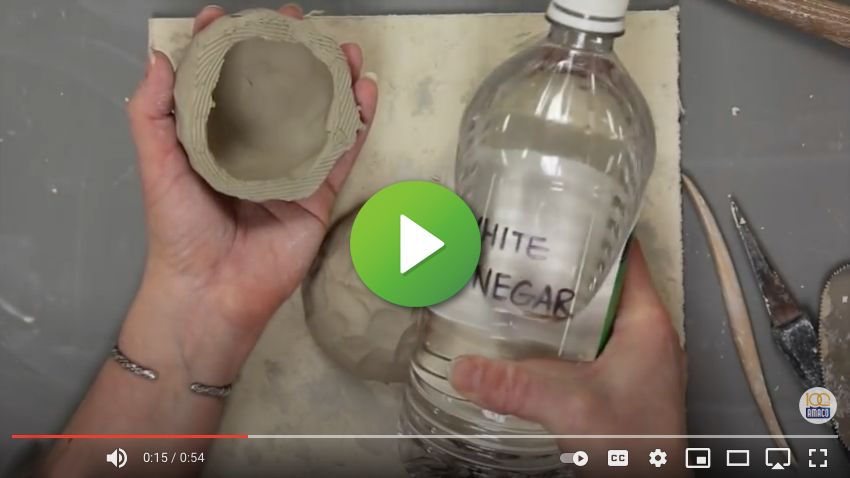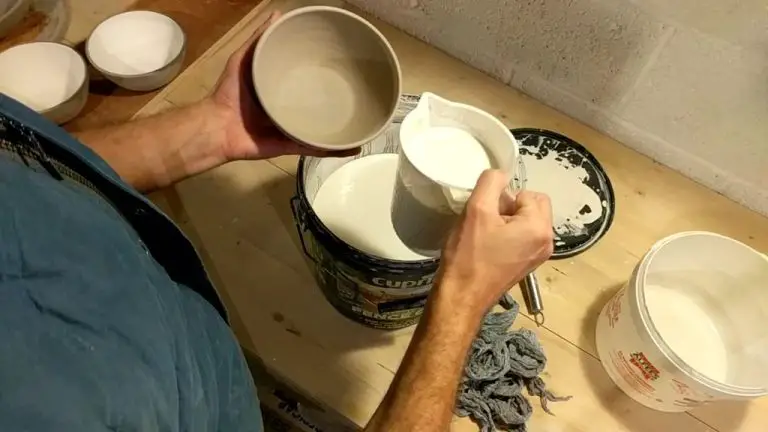Why Add Vinegar To Clay Slip?
Clay slip, also known as liquid clay, is a liquid mixture of clay and water used in pottery and ceramics. It serves several key functions:
Clay slip can be used as an adhesive to join pieces of unfired clay together, acting like glue before firing. It fills gaps and bonds surfaces.[1]
Slip is excellent for pouring into molds to create pottery forms with smooth, professional surfaces. The liquid clay picks up all the detail of the mold.[2]
As a thinner consistency than clay, slip can be painted onto leather-hard clay as decoration. Different colored slips create patterns when layered.
Applying slip to bisque ware before glazing provides an impervious layer for glazes to better adhere to the clay body beneath.
In summary, clay slip serves as glue, surface coating, decorative accent, and helps build thickness and form in pottery.
Acidifying the Clay
Vinegar is an acidic substance primarily composed of acetic acid and water. The acetic acid in vinegar disassociates into acetate ions and hydrogen ions when mixed into water, making the solution acidic. Acetic acid has a low pH around 2-4 depending on the vinegar concentration.
When added to clay slip, the acidic vinegar reacts with clay particles which are primarily made up of silicate minerals. These silicate minerals contain metal cations like aluminum, iron, magnesium, and calcium. The hydrogen ions from the acetic acid interact with the metal cations in the clay structure, donating protons which allows more sodium, potassium, and magnesium ions to go into solution. This acidification of the clay allows more fine particles to go into suspension and improves the working properties of the clay slip.
According to research, adding 1-3% vinegar by volume to clay slip can effectively increase fluidity and prevent flocculation without drastically altering the fired properties. The acetic acid provides just enough protonation to improve workability without excessively attacking the clay structure (Healthline).
Preventing Flocculation
Flocculation is when clay particles clump together and settle out of the slurry or slip. This can cause unevenness and flaws in the final piece. Vinegar helps prevent flocculation by lowering the pH of the slip, which keeps the clay particles suspended evenly. The acetic acid in vinegar helps repel the charges on the clay particles so they don’t clump together as easily (1). Using 2-3% vinegar by volume is often recommended to provide enough acidity to prevent flocculation without overly thinning the slip (2). Proper mixing and deflocculating is key for an even clay body.
(1) [Flocculation definition](https://digitalfire.com/glossary/flocculation)
(2) [Vinegar and flocculation](http://www.potters.org/subject111504.htm)
Increasing Fluidity
Adding vinegar to clay slip improves flow and increases fluidity. Vinegar acts as a deflocculant, preventing the clay particles from clumping together. This thins out the mixture and enhances the flow properties, allowing the slip to spread more smoothly and easily.
According to the Amaco article, vinegar straight from the bottle can be used to thin clay and make a joining slip with better fluidity. The acetic acid in vinegar separates the clay particles, reducing viscosity. This allows the slip to have a creamier, smooth consistency that pours and spreads nicely.
Removing Bubbles
One of the benefits of adding vinegar to clay slip is that it helps release trapped air bubbles. As clay is wedged or mixed, small pockets of air can get folded into the clay body. These air bubbles remain trapped in the clay as it is worked. When fired, these bubbles can expand and create small holes or pits in the final ceramic piece.
Adding a small amount of vinegar to the clay introduces microscopic bubbles that help dislodge the larger trapped air pockets. As the vinegar is incorporated into the clay, the tiny new bubbles move through the clay and merge with the larger bubbles. This causes the larger bubbles to rise to the surface and pop, releasing them from the clay.
According to an article on The Sculptor’s Funeral, “Vinegar is a flocculant – meaning it encourages clay particles to fall out of suspension. We want this, to settle the finer particles quickly, in order that the air bubbles can escape.”1 The acetic acid in vinegar creates an effervescent effect that enables trapped bubbles to be released.

Adding a small splash of vinegar when wedging or mixing clay is an easy and effective way to remove both large and microscopic air bubbles. This helps minimize pitting and creates an overall smoother surface when fired.
Adjusting Color
Vinegar can be used to make subtle shifts in the color of clay slips. The acetic acid in vinegar slightly lowers the pH of the slip, which can cause certain clay minerals to change color. For example, adding a small amount of vinegar to an iron-bearing red clay slip may shift the color slightly towards yellow or orange. Too much vinegar can make more drastic color changes. The amount needed to adjust color varies based on the clay body, so testing samples is recommended.
According to Vinegar vs. slip – Studio Operations and Making Work, vinegar works by electrically attracting the clay particles to each other, similarly to how it causes flocculation in glazes. This aggregation of particles can alter their light reflecting properties and cause color shifts.
Killing Bacteria
Vinegar is well known for its antimicrobial properties. When added to clay slip, the acetic acid in vinegar helps inhibit the growth of mold, bacteria, and other microorganisms that can damage clay pieces.
According to digitalfire.com, vinegar introduces acidity into clay bodies which makes the clay environment inhospitable for bacteria and molds to thrive. The acidic pH kills bacteria and prevents further microbial growth.
This antimicrobial effect is beneficial for keeping clay slip in a usable state for longer. It also helps make finished pieces more resistant to mold growth, especially in humid environments. Adding a small amount of vinegar to slip provides a simple and non-toxic way to control bacteria and fungi.
Improving Finishes
Adding a small amount of vinegar to clay slip can help create a smoother finish when using the slip and stain technique. The acetic acid in vinegar lowers the pH of the slip, making it slightly acidic. This acidity helps the clay particles disperse more evenly in the water, creating a smoother consistency.
Using a vinegar-water mixture for the final coat of slip helps refine the surface and minimize brush marks. Often 1-2 tablespoons of vinegar per cup of slip is sufficient. The vinegar helps the slip spread thinly and evenly over the bisque surface (Ceramic Arts Daily Forums). A smoother slip leads to a more even application of stains and glazes as well.
Keep in mind that too much vinegar can make the slip too thin and runny. Start with small amounts of vinegar and test the consistency before applying to your piece. The right amount of vinegar can dramatically improve the smoothness of the final surface.
Recommended Amounts
The typical ratio of vinegar to slip depends on the desired effect. According to thepotterywheel.com, a standard ratio is 1 part white distilled vinegar to 20 parts slip by volume. This helps create moderate fluidity and prevent flocculation. For more fluidity, use a 1:10 ratio. To kill bacteria or fully deflocculate, use a 1:5 ratio. For minimal effect, 1:30 is sometimes used. Ultimately the ratio can range from 1:5 to 1:30 vinegar to slip, with 1:10 to 1:20 being common.
Conclusion
In summary, there are a number of benefits to adding vinegar to clay slip before throwing a pot or sculpting:
- Acidifying the clay prevents flocculation so the clay particles remain suspended and have better plasticity.
- Vinegar increases the fluidity of the clay which improves workability.
- It helps remove bubbles from the clay which can otherwise get trapped and explode, ruining the piece.
- Small amounts of vinegar can be used to adjust the color of natural clays.
- The acetic acid kills bacteria which can grow in the moist clay and cause staining or odors.
- Vinegar improves the finishes of glazes and makes decorative slips adhere better.
Overall, a small addition of vinegar to clay slip provides potters and ceramic artists with an inexpensive but effective way to optimize the properties of their clay for constructing high quality pieces.


